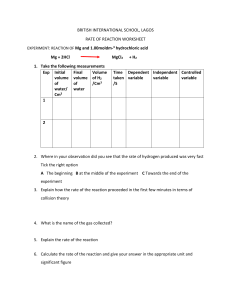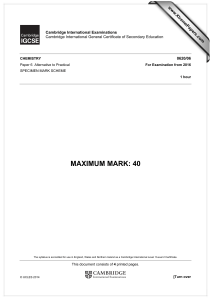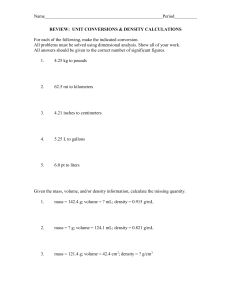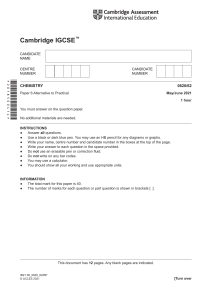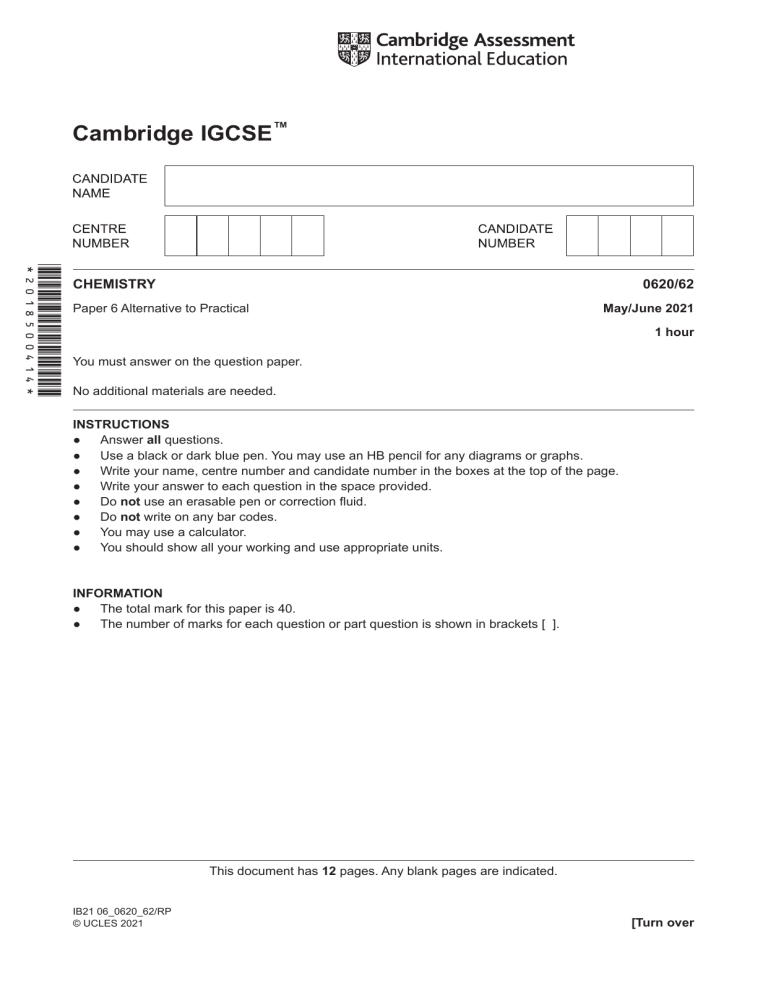
Cambridge IGCSE™ *2018500414* CHEMISTRY0620/62 Paper 6 Alternative to Practical May/June 2021 1 hour You must answer on the question paper. No additional materials are needed. INSTRUCTIONS ●● Answer all questions. ●● Use a black or dark blue pen. You may use an HB pencil for any diagrams or graphs. ●● Write your name, centre number and candidate number in the boxes at the top of the page. ●● Write your answer to each question in the space provided. ●● Do not use an erasable pen or correction fluid. ●● Do not write on any bar codes. ●● You may use a calculator. ●● You should show all your working and use appropriate units. INFORMATION ●● The total mark for this paper is 40. ●● The number of marks for each question or part question is shown in brackets [ ]. This document has 12 pages. Any blank pages are indicated. IB21 06_0620_62/RP © UCLES 2021 [Turn over 2 1Barium sulfate is an insoluble salt. Barium sulfate can be made by reacting excess aqueous sodium sulfate with aqueous barium chloride. sodium sulfate + barium chloride → sodium chloride + barium sulfate A student made a sample of barium sulfate using the following steps. step 1 aqueous sodium sulfate step 2 step 3 residue of solid barium sulfate A stir B aqueous barium chloride excess aqueous sodium sulfate was added to aqueous barium chloride the mixture was stirred the solid barium sulfate was removed from the mixture (a)Name the items of apparatus labelled A and B. A ................................................................................................................................................. B ................................................................................................................................................. [2] (b)Name the process shown in step 3. ............................................................................................................................................... [1] (c)The general name for the solid in step 3 is residue. State the general name for the solution obtained from the process in step 3. ............................................................................................................................................... [1] © UCLES 2021 0620/62/M/J/21 3 (d)Two more steps, step 4 and step 5, are needed to obtain a pure sample of barium sulfate. In each of these steps something is removed from the residue. State what is done in each of step 4 and step 5 and identify the substance removed from the barium sulfate. step 4 ......................................................................................................................................... ..................................................................................................................................................... substance removed .................................................................................................................... step 5 ......................................................................................................................................... ..................................................................................................................................................... substance removed .................................................................................................................... [4] © UCLES 2021 [Total: 8] 0620/62/M/J/21 [Turn over 4 BLANK PAGE © UCLES 2021 0620/62/M/J/21 5 2 A student investigated the volume of gas made when sodium carbonate reacts with dilute hydrochloric acid. Five experiments were carried out using the apparatus shown. rubber delivery tube clamp bung inverted 100 cm3 measuring cylinder boiling tube trough water Experiment 1 ●● Using a measuring cylinder, 16 cm3 of dilute hydrochloric acid was poured into a boiling tube. ●● The apparatus was set up as shown in the diagram. ●● The bung was removed from the boiling tube. ●● 2.5 g of sodium carbonate was added to the boiling tube and the bung was immediately replaced. ●● When no more gas was being collected, the volume of gas in the measuring cylinder was measured. Experiment 2 ●● Experiment 1 was repeated using 14 cm3 of dilute hydrochloric acid instead of 16 cm3. Experiment 3 ●● Experiment 2 was repeated using 12 cm3 of dilute hydrochloric acid instead of 14 cm3. Experiment 4 ●● Experiment 3 was repeated using 10 cm3 of dilute hydrochloric acid instead of 12 cm3. Experiment 5 ●● Experiment 4 was repeated using 6 cm3 of dilute hydrochloric acid instead of 10 cm3. © UCLES 2021 0620/62/M/J/21 [Turn over 6 (a)Use the information in the description of the experiments and the inverted measuring cylinder diagrams to complete the table. experiment volume of dilute hydrochloric acid / cm3 inverted measuring cylinder diagram volume of gas collected / cm3 40 50 1 60 40 50 2 60 40 50 3 60 30 40 4 50 20 30 5 40 [3] © UCLES 2021 0620/62/M/J/21 7 (b)Write a suitable scale on the y-axis and plot the results from Experiments 1 to 5 on the grid. Draw a straight line of best fit. volume of gas collected / cm3 4 6 8 10 12 14 16 volume of dilute hydrochloric acid / cm3 [4] (c) (i) From your graph, deduce the volume of gas that would be collected if 7 cm3 of dilute hydrochloric acid was used. Show clearly on the grid how you worked out your answer. .............................. cm3 [2] (ii)The volume of gas made per cm3 of dilute hydrochloric acid can be calculated using the equation shown. volume of gas per cm3 of acid = volume of gas collected in cm3 volume of acid in cm3 Use this equation and your answer to (c)(i) to calculate the volume of gas made per cm3 of dilute hydrochloric acid. © UCLES 2021 .............................. [1] 0620/62/M/J/21 [Turn over 8 (d)The bung was removed and then replaced immediately after the sodium carbonate was added to the boiling tube. (i)Explain why the bung must be replaced immediately after the sodium carbonate is added to the boiling tube. .............................................................................................................................................. ........................................................................................................................................ [1] (ii)Explain how the apparatus could be altered so that the bung does not have to be removed. You may draw a diagram to explain your answer. .............................................................................................................................................. ........................................................................................................................................ [2] (e)State one advantage of using a burette rather than a measuring cylinder to measure the volume of the dilute hydrochloric acid. ............................................................................................................................................... [1] (f)In Experiments 1 to 5, the sodium carbonate was in excess. Sketch on the grid the graph you would expect if all of the experiments were repeated using dilute hydrochloric acid of half the concentration. Label your line F.[2] © UCLES 2021 [Total: 16] 0620/62/M/J/21 9 3Solution G and solid H were analysed. tests on solution G tests observations Solution G was divided into three equal portions in three test‑tubes. test 1 Sodium hydroxide was added dropwise and then in excess to the first portion of solution G. white precipitate which did not dissolve in excess test 2 About 1 cm3 of dilute nitric acid followed by a few drops of aqueous silver nitrate were added to the second portion of solution G. yellow precipitate test 3 About 10 cm3 of aqueous hydrogen peroxide was added to the third portion of solution G. The gas produced was tested. the mixture became brown and bubbled; the gas relit a glowing splint (a)Identify the gas produced in test 3. ............................................................................................................................................... [1] (b)Use the results of test 1 and test 2 to identify solution G. ..................................................................................................................................................... ..................................................................................................................................................... ............................................................................................................................................... [2] © UCLES 2021 0620/62/M/J/21 [Turn over 10 tests on solid H Solid H was hydrated copper(II) sulfate. Complete the expected observations. (c)About half of solid H was placed in a boiling tube and heated using a Bunsen burner. observations ............................................................................................................................... ............................................................................................................................................... [2] (d)A flame test was carried out on solid H. observations ......................................................................................................................... [1] The remaining solid H was placed in a boiling tube. About 10 cm3 of distilled water was added to the boiling tube. The tube was shaken to dissolve solid H and form solution H. Solution H was divided into two approximately equal portions in two test‑tubes. (e)Aqueous ammonia was added dropwise and then in excess to the first portion of solution H. observations ............................................................................................................................... ..................................................................................................................................................... ............................................................................................................................................... [3] (f)Approximately 1 cm3 of dilute nitric acid followed by a few drops of aqueous barium nitrate were added to the second portion of solution H. observations ......................................................................................................................... [1] © UCLES 2021 [Total: 10] 0620/62/M/J/21 11 4The mineral epsomite contains hydrated magnesium sulfate. When epsomite is heated strongly, it loses water and eventually becomes anhydrous magnesium sulfate. Plan an investigation to find the percentage by mass of water in a sample of epsomite. Your plan should include how you would calculate the percentage by mass of water in epsomite. You have access to common laboratory apparatus. ............................................................................................................................................................ ............................................................................................................................................................ ............................................................................................................................................................ ............................................................................................................................................................ ............................................................................................................................................................ ............................................................................................................................................................ ............................................................................................................................................................ ............................................................................................................................................................ ............................................................................................................................................................ ............................................................................................................................................................ ............................................................................................................................................................ ............................................................................................................................................................ ............................................................................................................................................................ ............................................................................................................................................................ ............................................................................................................................................................ ............................................................................................................................................................ ............................................................................................................................................................ ............................................................................................................................................................ ...................................................................................................................................................... [6] © UCLES 2021 0620/62/M/J/21 [Turn over 12 BLANK PAGE Permission to reproduce items where third-party owned material protected by copyright is included has been sought and cleared where possible. Every reasonable effort has been made by the publisher (UCLES) to trace copyright holders, but if any items requiring clearance have unwittingly been included, the publisher will be pleased to make amends at the earliest possible opportunity. To avoid the issue of disclosure of answer-related information to candidates, all copyright acknowledgements are reproduced online in the Cambridge Assessment International Education Copyright Acknowledgements Booklet. This is produced for each series of examinations and is freely available to download at www.cambridgeinternational.org after the live examination series. Cambridge Assessment International Education is part of the Cambridge Assessment Group. Cambridge Assessment is the brand name of the University of Cambridge Local Examinations Syndicate (UCLES), which itself is a department of the University of Cambridge. © UCLES 2021 0620/62/M/J/21
